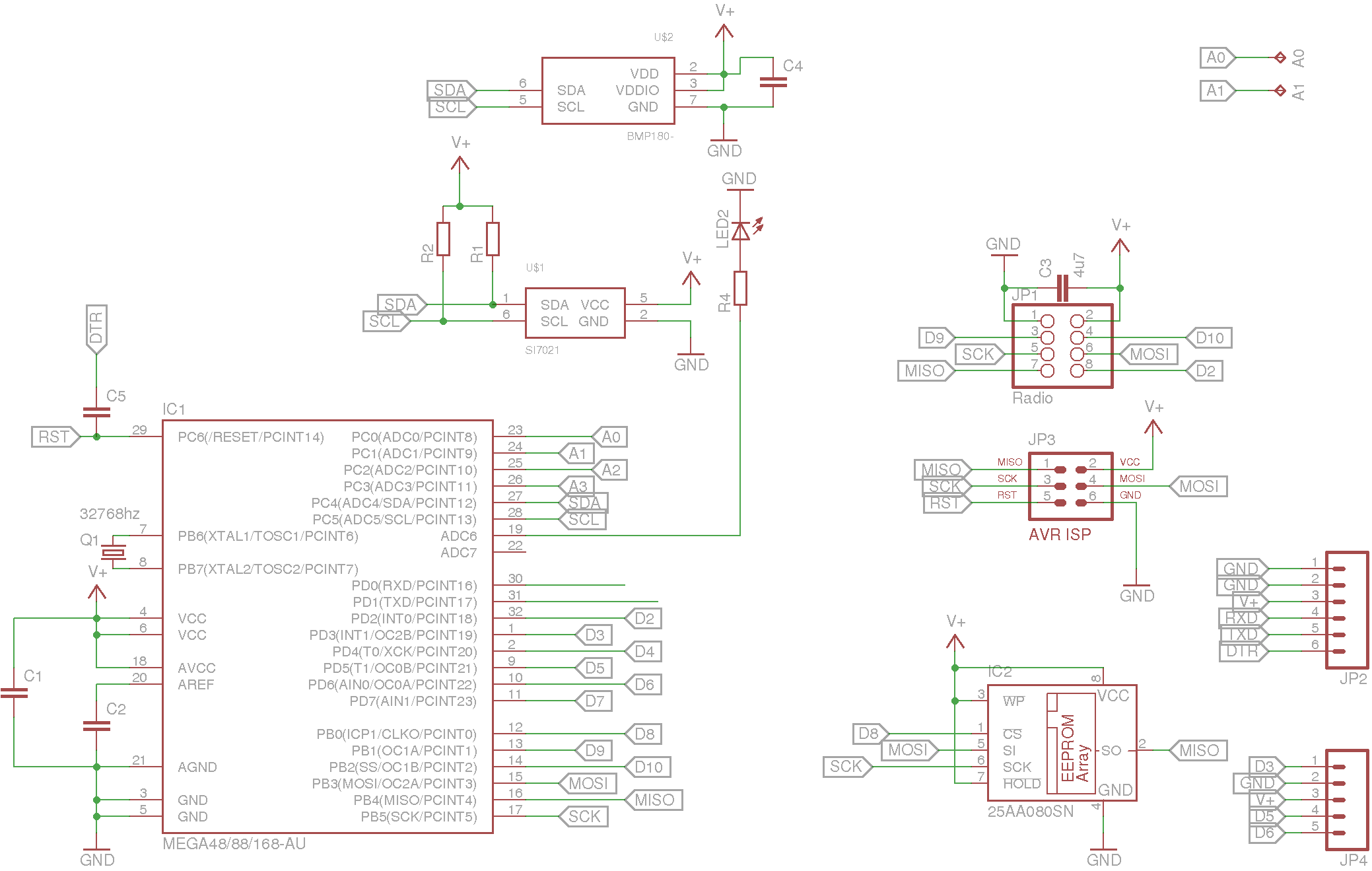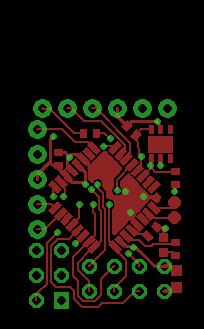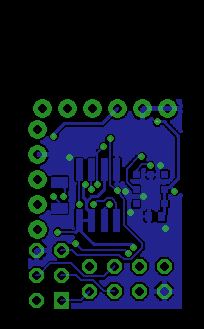Minimal design thoughts
-
Any thoughts on how to panelize it? You'd get like six boards on a 5x5 if those dimensions hold? Perhaps you could do some alternative layouts for different sensors? I understand dirtypcbs no longer do grooving (if they ever did) ... how much pcb space is lost to routing typically?
In case anyone else is wondering about dirtypcbs, they seem to do an ok job typically:
http://lab.kjlr.dk/p/handystick
http://hackers.gallery/236/electronics/pcb-itead-studio-vs-dirtypcbs -
The full size is 16x31 mm at the moment. So it's almost the same size as the normal nrf24 modules on ebay. So if I panelize them i can get 4 modules in total on a single 5x5 area.
Let's see when i come around to order them. I just like the dirty pcb as it reminds me of a song from my favorite rockband (ac/dc) :)
-
Arh.. just found out that the pinheader for the radio was turned 180 degrees, so instead of the 2 boards being on top of eatch other, they would "go in two different directions". Had to rip up most of the board, and re-arrange things again.

only changes on the schematic, is that the LED's are moved to a couple of other pins.
/ Thomas
-
Very interesting, this one board would cover all that I need for the majority of my sensors. Would need a couple of sensors with IR, and a couple of others. Is the reason for this the reduced foot print, a reduced cost over arduino pro's, or something else?
-
One of the reasons is that I wanted to go with battery, without all the extra "cruft" that is on standard arduino boards (like regulators etc.),
Also I want to make it as clean as possible, as I'm planning on creating 10-20 nodes in total I don't like to make them as "birdsnests" with multiple boards stiched together with wires.
It also almost became an obsesson to see how small I could get it :).
Maybe I can save a little $ by roling my own layout, but not the main driving force.
-
One of the reasons is that I wanted to go with battery, without all the extra "cruft" that is on standard arduino boards (like regulators etc.),
Also I want to make it as clean as possible, as I'm planning on creating 10-20 nodes in total I don't like to make them as "birdsnests" with multiple boards stiched together with wires.
It also almost became an obsesson to see how small I could get it :).
Maybe I can save a little $ by roling my own layout, but not the main driving force.
@tbowmo Ahh, understood! I too plan for, somewhere around 20 nodes. However I plan to wall wort power most of mine. The only real exception will be a few outside, and inconvenient to reach places.
I do like the idea of eliminating as much of the "birds nest" as possible... My first couple of, what I am currently calling prototype sensors, are, well inside their boxes, very ugly. haha.
-
@tbowmo Very nice design!
Personally I would make something similar but with the option to charge things using an external solar cell or just a charger. With the new generation of low-leakage NiMH rechargeable batteries I am very tempted using these to power the sensor.
-
Is it necessary to use solar power? A couple of standard AA batteries, is probably good for 2000mAh, and with a consumption of below 50uA, you got battery power for 4-5 years..
Also the sun doesn't shine inside my house ;)
/ Thomas
-
Is it necessary to use solar power? A couple of standard AA batteries, is probably good for 2000mAh, and with a consumption of below 50uA, you got battery power for 4-5 years..
Sounds great, 4-5 years without changing batteries but will that be real? The bad thing is that if true it take 4-5 years to prove it.
Also the sun doesn't shine inside my house
But a solar cell does not need solar to generate (some) current unless your house is completely dark ;-)
But yes, if it is only 2-3 year going with rechargeable batteries is overkill.
-
Is it necessary to use solar power? A couple of standard AA batteries, is probably good for 2000mAh, and with a consumption of below 50uA, you got battery power for 4-5 years..
Sounds great, 4-5 years without changing batteries but will that be real? The bad thing is that if true it take 4-5 years to prove it.
Also the sun doesn't shine inside my house
But a solar cell does not need solar to generate (some) current unless your house is completely dark ;-)
But yes, if it is only 2-3 year going with rechargeable batteries is overkill.
@daulagari said:
Is it necessary to use solar power? A couple of standard AA batteries, is probably good for 2000mAh, and with a consumption of below 50uA, you got battery power for 4-5 years..
Sounds great, 4-5 years without changing batteries but will that be real? The bad thing is that if true it take 4-5 years to prove it.
Probably not 4-5 years (it was just quick, off the head, calculations), but I would think that at least 2 years of service time should be obtainable.. But yes, we will first see it in a couple of years :D
Also the sun doesn't shine inside my house
But a solar cell does not need solar to generate (some) current unless your house is completely dark ;-)
But yes, if it is only 2-3 year going with rechargeable batteries is overkill.
I plan to place my sensors in corners, or somewhere else, where there isn't any direct light on them. And then they don't create enough power to charge the batteries., so solarpower is just adding to the cost of the project, without any real benefit..
-
Woah, wait.... 2 years of power?? Okay, if I could even get, say 18 months, I would go with battery powered over wall worts in a majority of my sensors.
I was assuming battery power may last 3-6 months or so, given the motion detection.
-
Woah, wait.... 2 years of power?? Okay, if I could even get, say 18 months, I would go with battery powered over wall worts in a majority of my sensors.
I was assuming battery power may last 3-6 months or so, given the motion detection.
@NotYetRated said:
Woah, wait.... 2 years of power?? Okay, if I could even get, say 18 months, I would go with battery powered over wall worts in a majority of my sensors.
I was assuming battery power may last 3-6 months or so, given the motion detection.
With motion detection you probably are further down, also one problem is that the PIR sensors I have seen is only 3.3V, which means you need a step up converter to power it from battery. This also increases the powerdrain on the batteries.
-
Ahh okay. Ill stick with building my stuff out for wall power where possible, and probably test a few of your boards when available. :)
-
@tbowmo Cool staff!
Just one suggestion - to add so called FTDI programming interface like pro mini is using
It allows to use an external USB<->UART converter to work ith the board as usual (using programming through bootloader and Serial debugger)
It is simple, see PROGRAMMER connector for example here http://wiki.devicter.ru/images/f/f7/SNv3sch.png -
@axillent
Hmm have been thinking about it.. Just for the versatility of the unit for other people. I have plans to use good old atmel programmers (I have a bunch of them, both jtagice3, and the older serial/usb programmers), so it's not that big an issue for me to skip serial for programmingAnd at the moment I can't find any room for it the serial (other than rxd/txd in upper right corner) It's almost become an obsession for me, to keep it at the small formfactor :) (Same size as a standard nrf24 module). Just to prove that it is possible to get it that small
btw. squeezed a couple of testpads in for A0, A1 and D3 last night.
-
An update.. I got room for the ftdi header, as well as a 4pin header where I got power, and 3 digital IO (D3, D6 and D7, if I my memory serves me). Just need to find location for the last couple of tracks
Only detail though, is that I have gone with 0402 size smd components..
/ Thomas
-
And the latest schematic, and layout (After I scratched the old routing, and started all over, again, for the 5th time I think :))
Actually I enjoy this fiddling with placing components, and routing tracks.. Only problem is that the wife thinks it takes too much time, and I should do other more usefull stuff, than playing with my computer, making noncense drawings :)
Schematics

full layout

top layer

bottom layer

Think I am ready to press the GO button for first spin in china.. This is gonna be exciting :)
